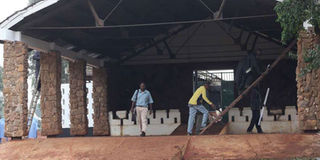How cremation takes place

Preparations are ongoing at Lang'ata Cemetery Crematorium on April 26, 2018 ahead of the cremation of Kenneth Matiba. PHOTO | MARTIN MUKANGU | NATION MEDIA GROUP
What you need to know:
- Cremation usually takes about six to seven hours and involves the burning of the body while inside the coffin.
- At the crematorium, families can choose to have their relatives cremated at an open kiln as they watch or at a closed kiln.
Politician and second liberation champion Kenneth Matiba will today be cremated at the Lang'ata Cemetery Crematorium in Nairobi, joining a list of prominent Kenyans who have opted out of the traditional burial rites.
The crematorium was yesterday a hive of activities as the Matiba family, government officials and the Nairobi City County officers prepared the venue for the final rites.
Mr Nderitu Maina, who is in charge of the cemetery, said the procedure is tedious and must be done meticulously.
Cremation, he said, usually takes about six to seven hours and involves the burning of the body while inside the coffin, in line with Ministry of Health regulations.
PROCEDURE
The body will be exposed to a temperature of between 1,000 to 2,000 degrees Celsius.
Cremation at Lang'ata costs Sh16,800 for an adult and Sh12,000 for a child.
Mr Maina said the process begins at the City Mortuary, where a family requests and pays for a notice for cremation. This is then presented to the crematorium.
The coffin is then wheeled into the kiln before its heavy door, reinforced with mortar, is shut and the diesel-fuelled fire lit at the head of the coffin.
The family selects one member to light the fire.
“It takes an average of six to seven hours for the body to burn fully,” Mr Maina said, adding that the few bones left and the ashes are then taken to the City Mortuary for collection by relatives in urns.
BURNING
A single body requires about 40 litres of diesel to burn fully. “The ashes weigh between half or quarter a kilo,” he said.
Inside the building, whose doors opened in 1968, is a small-roofed area with green concrete park benches and two rooms with large brick kilns.
There are two towering chimneys and a red brick roof situated on one end of the cemetery.
At the Kariokor Crematorium, bodies are laid on pyres placed on a metallic surface, logs are placed on the body and ghee sprinkled to speed up the burning.
CHARGES
Sawdust and small pieces of firewood are placed beneath the pyres and the closest male relative — the husband, first son or another close relation — then lights the fire.
The Hindu Crematorium charges a flat rate of Sh10,000 for a member of the Hindu community and Sh22,500 for a non-Hindu.
At the crematorium, families can choose to have their relatives cremated at an open kiln as they watch or at a closed kiln.





